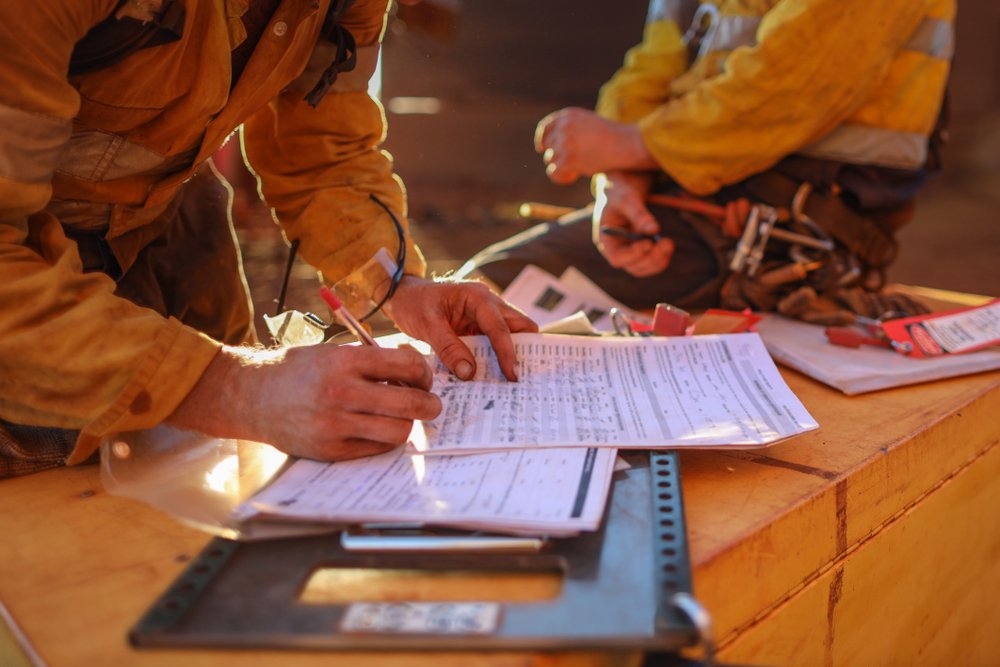Construction is without a doubt a high-risk industry — workers often work from a height, use dangerous tools and machinery, and carry out tasks on hazardous building sites. So effective risk management policies and procedures are hugely important for keeping employees, contractors and site visitors safe from harm.
But there’s more to risk management than health and safety. While health and safety in construction is important, there are many different aspects of risk management that construction companies need to consider.
In this article, we’ll explore 13 key areas of risk management in construction. By mitigating risks in these areas, you can protect your business from financial loss and reputational damage and ensure your employees are as safe as possible.
1. Health and Safety
Managing health and safety risks is highly important in any industry, but in construction, workers face high-level risks on a daily basis.
Construction sites are rife with hazards — last year alone, 79,000 construction workers suffered from work-related injuries or ill-health. So companies in this industry need to ensure effective health and safety risk management strategies are implemented consistently — the slightest lapse in health and safety can lead to serious injuries.
Construction companies can drastically reduce risks with risk assessments, method statements, and written health and safety policies and procedures. Communication and training about health and safety in the workplace are also integral to health and safety risk management.
2. Identity
Behind every business relationship is trust, and behind that trust is identity. Clients want to know exactly who they’re working with when they hire contractors so that they can minimise identity risk. By verifying factors relating to the identity of contractors, clients can ensure that they select contractors who are suitably qualified, experienced, reliable and trustworthy.
Identity risk management is very important as clients need to know exactly who they are granting access to sites and trusting with important projects, equipment and information.
3. Financial
Every company or sole contractor will face financial risks, so it should come as no surprise that financial risk management is something that all companies and individual contractors need to consider. Anything that can affect a business’s finances is a financial risk — in the construction industry, a few examples of financial risks that companies may face include seasonal cash flow shortages, late payments from clients, and increased costs of materials. But in reality, there are hundreds of different factors that could affect a company’s financial health.
Financial risk management involves considering how different scenarios may affect the company’s finances, and planning for all possibilities. Companies should work to understand how different factors can have a financial impact and what can be done to minimise that impact. Understanding financial risk factors can also help companies make better-informed decisions.
Free Risk Assessment Template
Take the stress and confusion out of creating a risk assessment with our free template.
Enter your details, and we’ll email you a risk assessment template that’s both compliant and comprehensive to use.
By submitting this form you confirm you are happy to be contacted by CHAS in accordance with our Privacy Policy
4. Insurance
Contracting work comes with financial and legal risks. Whether you provide building services or work as a freelance subcontractor, it’s understood that you accept certain obligations and responsibilities.
Business insurances are essential not just because they’re a legal requirement but also because they protect you from the financial and legal costs of mistakes, accidents, theft and damage. Insurance ensures that your business can keep running, even when things go wrong.
And with construction clients in both the private and public sectors often having specific insurance requirements, having the right level of insurance will help you pre-qualify for work faster.
Insurance is a key foundational element of a well-run contracting business.
- It assures clients that they have legal protection against contractor mistakes or negligence.
- It protects you from financial damages — something you won’t get from an agency contract.
- Basic insurance cover, such as public liability insurance, is almost always a contractual requirement of any construction contract.
5. Corporate and Professional Standing
Corporate and professional standing can affect the reliability and risk level of a company. So organisations need to ensure that good corporate and professional standing is demonstrated on all levels. The organisation as a whole must maintain professional integrity, comply with codes of conduct, hold the necessary qualifications and accreditations, and meet all legal obligations.
But for organisations to maintain good professional standing, individuals within the company also need to demonstrate high standards of professionalism. This is especially important for team members such as Executive Officers and Directors, who act as company representatives or have influence over important company decisions.
Risk management in this area can involve ensuring compliance and vetting employees to make sure no individual threatens the reputation or professional integrity of the company. Not only should companies assess their own professional standing, but if any contracting companies are hired to complete projects, the professional standing of third-party companies should be assessed before contracts are agreed.
6. Anti-Bribery and Corruption
Corruption or bribery in the business world can lead to serious financial loss and reputational damage — businesses have a moral and legal obligation to combat corruption. While most companies won’t face bribery or corruption, it does happen. So construction businesses need to be aware of corruption risks and how to mitigate them.
Companies should consider what realistic corruption risks they may face. They then need to assess the likelihood of these risks being realised and the effect they could have on the company and those involved. Steps can then be taken to reduce opportunities for corruption.
Learn More About The Common Assessment Standard
The Common Assessment Standard is the highest recognised compliance accreditation in construction, facilities, housing, social care and education.
Discover what it is and how it can benefit your organisation, creating new opportunities and growth for your business.
Enter Your Details For A Callback On The Common Assessment Standard.
By submitting this form you confirm you are happy to be contacted by CHAS in accordance with our Privacy Policy
7. Modern Slavery
Modern slavery is a very real issue in the UK. It’s present in all areas of the UK, in many different industries as well as in domestic situations, and can take many different forms. The construction industry in particular is a high-risk industry for labour exploitation.
Modern slavery in construction includes but is by no means limited to human trafficking and child labour. It can also take the form of employers withholding pay, paying unfair wages, or forcing workers to work in unsafe conditions.
Managing modern slavery risks starts with identifying where risks may arise. To effectively identify potential instances of exploitation, companies need to understand the root causes and drivers of modern slavery and know which indicators to look out for. Short, medium and long-term risk management strategies can then be implemented.
Companies should refer to the Modern Slavery Act 2015 for guidance, and ensure compliance with modern slavery legislation.
8. Environmental
The nature of construction work means every project will have an impact on the environment, but it is possible for this impact to be minimised. So environmental responsibility and risk management should be a priority for construction companies.
Construction projects are often responsible for large amounts of landfill waste, water, air and noise pollution, and vegetation removal. The manufacture of building materials and the operation of machinery during construction projects can also use huge amounts of energy, contributing to global warming.
Environmental risk management involves taking steps to identify environmental risks and minimise the impact of construction work on the environment. Environmental risk management plans should consider the impact of construction on air and water quality, noise and vibration, people and local communities, the landscape, archaeological sites and more.
9. Quality
Quality is one of the most important areas of risk management in construction. If construction work isn’t completed to a high standard, completed structures can pose serious health and safety risks. Work that doesn’t meet quality management standards can also incur rework costs and cause reputational damage, potentially costing companies future work opportunities.
So a key aspect of risk management for construction companies is quality control. This involves creating quality policies and management plans that outline the quality of products and materials to be used, and the expected standard of completed work. Quality management plans will often form part of the contract between clients and contractors.
10. Equality, Diversity and Inclusion (EDI)
Companies in all industries are legally required to promote equality and diversity in the workplace in order to ensure equal opportunities for everyone. Equality and diversity can also play an important role in the success of businesses — diversity at work can improve employee satisfaction and retention and diverse workforces often benefit from a range of skills, approaches and expertise.
Companies need to identify and eliminate discrimination risks. By eliminating discrimination and promoting equality, companies can unlock business benefits, comply with legislation such as the Equalities Act 2010, demonstrate progressive company culture and maintain a good reputation and professional standing.
11. Corporate Social Responsibility
Corporate social responsibility is a crucial element of risk management. CSR encourages companies to identify the environmental and social impact their business operations have, accept responsibility, and most importantly, take steps to minimise any risks and negative influence. Risks in the area of CSR can relate to human rights, work relationships, the protection of nature and the environment and more.
12. Information Security
Technology has made collecting data easier than ever before. Every company collects personal and potentially sensitive data from different people — from contact details to information about how users interact with company websites to records of customer communications. So data protection risk management should be a priority for all businesses.
Companies need to identify possible data protection risks such as the risk of data breaches, unlawful collection of data, and non-compliance with data protection regulations such as the GDPR.
13. Information Management
Information management through building information modelling involves using 3D models to digitally describe each stage of building projects. This process can help companies predict issues that may arise at different stages of projects, and identify risks across project timelines.
The ability to identify and mitigate risks before they occur makes building information modelling a key area of risk management in construction.
How to Ensure Effective Risk Management across Your Company
These 13 key areas of risk management are hugely important for making sure business operations are as safe and risk-free as possible. Mitigating risks in these areas can protect people from harm and help companies safeguard against financial and reputational loss.
If you’re hoping to improve your company’s risk management strategies, CHAS can help. We offer leading risk management accreditation schemes such as CHAS Elite an accreditation programme covering all 13 areas of risk management mentioned in this article. We can also provide the support and guidance you need to achieve compliance.
Become a CHAS member today and gain access to risk management tools and materials and accreditation programmes. As a CHAS member, you can effectively manage risks throughout your organisation, achieve compliance and accreditation, and prequalify for work opportunities.

Achieve the Industry’s highest recognised accreditation, backed by Build UK & CECA with CHAS Elite
The Common Assessment Standard streamlines the construction supply chain and makes it easier for companies to achieve compliance and gain accreditation.



